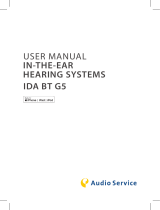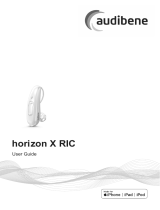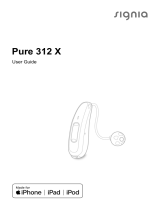Page is loading ...

USER MANUAL
RIC – HEARING SYSTEMS
IC G5 RIC LI

2
CONTENT
Welcome 4
Your hearing instruments 5
Instrument type 5
Getting to know your hearing instruments 6
Components and names 7
Controls 9
Hearing programs 10
Features 10
Daily use 11
Charging 11
Turning on and o 12
Switching to standby mode 13
Inserting and removing the hearing instruments 14
Adjusting the volume 18
Changing the hearing program 19
Further adjustments (optional) 19
Special listening situations 20
On the phone 20
Audio streaming with iPhone, iPad or iPod touch 21
Airplane mode 21

3
Maintenance and care 22
Hearing instruments 22
Ear pieces 25
Professional maintenance 27
Important safety information 28
Further information 30
Safety information 30
Accessories 30
Operating, transport and storage conditions 31
Disposal information 32
Symbols used in this document 32
Troubleshooting 33
Service and warranty 34

4
WELCOME
Thank you for choosing our hearing instruments to
accompany you through everyday life. Like anything new, it
may take you a little time to become familiar with them.
This guide, along with support from your Hearing Care
Professional, will help you understand the advantages and
greater quality of life your hearing instruments oer.
To receive the most benet from your hearing instruments, it
is recommended that you wear them every day, all day. This
will help you get adjusted to them.
CAUTION
It is important to read this user guide and the safety
manual thoroughly and completely. Follow the safety
information to avoid damage or injury.
Before using your hearing instruments for the rst
time, fully charge them. Follow the instructions in the
charger‘s user guide.

5
YOUR HEARING INSTRUMENTS
This user guide describes optional features that your
hearing instruments may or may not have.
Ask your Hearing Care Professional to indicate the
features that are valid for your hearing instruments.
INSTRUMENT TYPE
Your hearing instruments are a RIC (Receiver-in-Canal) model.
The receiver is placed within the ear canal and connected to
the instrument via a receiver cable. The instruments are not
intended for children under the age of 3 years or persons
with a developmental age of under 3 years.
A power cell (lithium-ion rechargeable battery) is
permanently built into your hearing instrument. This enables
easy charging with our inductive charger.
The wireless functionality enables advanced audiological
features and synchronization between your two hearing
instruments.
Your hearing instruments feature Bluetooth® low energy*
technology. This enables easy data transfer with your
smartphone, and for seamless audio streaming with your
iPhone, iPad or iPod touch**.
* The Bluetooth word mark and logos are owned by the Bluetooth SIG, Inc., and any use
of such marks by the legal manufacturer of this product is under licenses. Other trademarks
and trade names are those of their respective owners.
** iPhone, iPad and iPod touch are registered trademarks of Apple Inc., registered in the US
and other countries.

6
GETTING TO KNOW YOUR HEARING INSTRUMENTS
It is recommended to familiarize yourself with your new
hearing instruments. With the instruments in your hand try
using the controls and note their location on the instrument.
This will make it easier for you to feel and press the controls
while wearing the hearing instruments.
If you have problems pressing the controls of your
hearing instruments while wearing them, you
can ask your Hearing Care Professional whether a
remote control or a smartphone app to control your
instruments is available.

7
COMPONENTS AND NAMES
➏
➊ Ear piece
➋ Receiver
➌ Receiver cable
➍ Microphone openings
➎ Push button
(control, on/o switch)
➏ Side indicator
(red = right ear,
blue = left ear)
and receiver connection

8
You can use standard or custom-made ear pieces.
Standard ear pieces Size
Click Dome, Open or Closed
Click Dome Semi-open
Click Dome Double
Click Sleeve, Open or Closed
You can easily exchange the standard ear pieces. Readmore
in section „Maintenance and care“.
Custom-made ear pieces
CLIC MOULD

9
CONTROLS
With the push button you can, for example,
switch hearing programs. The Hearing Care
Professional has programmed your desired
functions to the push button.
Push button function L R
Press briey:
Program up
Volume up
Volume down
Tinnitus therapy signal level up
Tinnitus therapy signal level down
TV stream on/o
Press for about 2 seconds:
Program up
Volume up
Volume down
Tinnitus therapy signal level up
Tinnitus therapy signal level down
TV stream on/o
Activate/deactivate airplane mode

10
Push button function L R
Press for more than 3 seconds:
Turn on/o
L = Left, R = Right
You can also use a remote control to change hearing
programs and adjust the volume of your hearing
instruments. With our smartphone app you have even
more control options.
HEARING PROGRAMS
1
2
3
4
5
6
Read more in section „Changing the hearing program“.
FEATURES
The tinnitus therapy feature generates a sound to
distract you from your tinnitus.

11
DAILY USE
CHARGING
Place your hearing instruments in the charger.
nnFollow the instructions in
the charger‘s user guide.
You can also nd useful
tips for charging in the
charger‘s user guide.
LOW POWER INDICATION
You will hear an alert signal to indicate the power cell is
running low. The signal will be repeated every 15 minutes.
Depending on the usage of your hearing instruments,
you have approximately 1.5 hours to charge your hearing
instruments before they stop working.
REPLACEMENT OF THE POWER CELL
If the fully charged hearing instruments do not last over a full
day of use (16 hours regular use without audio streaming)
then we recommend to have the power cell replaced by your
Hearing Care Professional.

12
TURNING ON AND OFF
You have the following options to turn your hearing
instruments on or o.
Via charger:
nnTurning on: Take the instruments out of the charger.
The startup melody is played in your hearing instruments.
The default volume and hearing program are set.
nnTurning o: Place the hearing instruments in the charger.
Note that the charger must be connected to the power
supply. For details refer to the charger‘s user guide.
Via push button:
nnTurning on: Press and hold the push button until the
startup melody starts to play. Release the push button
while the melody is playing.
The default volume and hearing program are set.
nnTurning o: Press and hold the push button for several
seconds. Depending on the settings of your push button,
signal tones may be played before the hearing instrument
turns o.
See also the tips for charging in the charger‘s user guide.

13
SWITCHING TO STANDBY MODE
Via remote control or smartphone app, you can switch
your hearing instruments to standby mode. This mutes the
hearing instruments. When you leave standby mode, the
previously used volume and hearing program are set.
Note:
nnIn standby mode, the hearing instruments are not turned
o completely. They draw some power.
Therefore we recommend to use standby mode only for a
short period of time.
nnIf you want to leave standby mode, but the remote control
or app is not at hand: Turn your hearing instruments o
and on again (via push button or by shortly placing them
in the charger until one or more orange LEDs light up). In
this case, the default volume and hearing program are
set.

14
INSERTING AND REMOVING THE HEARING
INSTRUMENTS
Your hearing instruments have been ne-tuned for your right
and left ear. Colored markers indicate the
side:
nnred marker = right ear
nnblue marker = left ear
Inserting a hearing instrument:
nnWhen using Click Sleeves:
Ensure that the curve of the Click Sleeve corresponds with
the bend in the receiver cable.
Correct:
Incorrect:

15
nnHold the receiver cable at the bend closer to the ear piece.
nnCarefully push the ear piece in the
ear canal ➊.
nnTwist it slightly until it sits well.
Open and close your mouth to
avoid accumulation of air in the
ear canal.
nnLift the hearing instrument and
slide it over the top of your ear ➋.
CAUTION
Risk of injury!
nnInsert the ear piece carefully and not too deeply
into the ear.
nnIt may be helpful to insert the right hearing
instrument with the right hand and the left hearing
instrument with the left hand.
nnIf you have problems inserting the ear piece,
use the other hand to gently pull your earlobe
downwards. This opens the ear canal and eases
insertion of the ear piece..

16
The optional retention strand helps to securely retain the ear
piece in your ear. To position the retention strand:
nnBend the retention strand and position
it carefully into the bottom of the bowl
of your ear (refer to the picture).

17
Removing a hearing instrument:
nnLift the hearing instrument
and slide it over the top of your
ear ➊.
nnIf your hearing instrument is
equipped with a custom shell
or a CLIC MOULD, remove it by
pulling the small removal cord
toward the back of your head.
nnFor all other ear pieces: Grip the receiver in the ear canal
with two ngers and pull it carefully out ➋.
Do not pull the receiver cable.
CAUTION
Risk of injury!
nnIn very rare cases the ear piece could remain in your
ear when removing the hearing instrument. If this
happens, have the ear piece removed by a medical
professional.
Clean and dry your hearing instruments after usage.
Read more in section „Maintenance and care“.

18
ADJUSTING THE VOLUME
Your hearing instruments automatically adjust the volume to
the listening situation.
nnIf you prefer manual volume adjustment, press the push
button briey or use a remote control.
Refer to section „Controls“ for the setting of the push
button.
An optional signal tone can indicate the volume change.
Once the maximum or minimum volume has been reached,
you may hear an optional signal tone.

19
CHANGING THE HEARING PROGRAM
Depending on the listening situation, your hearing
instruments automatically adjust their sound.
Your hearing instruments may also have several hearing
programs which allow you to change the sound, if needed.
An optional signal tone can indicate the program change.
nnTo change the hearing program, press the push button
briey or use a remote control.
Refer to section „Controls“ for the setting of your controls.
Refer to section „Hearing programs“ for a list of your hearing
programs.
The default volume is applied.
FURTHER ADJUSTMENTS OPTIONAL
The controls of your hearing instruments can also be used to
change, for example, the tinnitus therapy signal level.
Refer to section „Controls“ for the setting of your controls.

20
SPECIAL LISTENING SITUATIONS
ON THE PHONE
When you are on the phone, hold the
telephone receiver slightly above your ear.
The hearing instrument and telephone
receiver have to be aligned. Turn the
receiver slightly so that the ear is not
completely covered.
TELEPHONE PROGRAM
You may prefer a certain volume when using the phone.
Ask your Hearing Care Professional to congure a telephone
program.
nnSwitch to the telephone program whenever you are on
the phone.
If a telephone program or the automatic program switch
are congured for your hearing instruments, it is listed in
section „Hearing program“.
/











